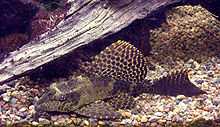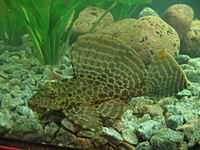Pterygoplichthys gibbiceps
| Pterygoplichthys gibbiceps | |
|---|---|
 | |
| Conservation status | |
| Not evaluated (IUCN 3.1) | |
| Scientific classification | |
| Kingdom: | Animalia |
| Phylum: | Chordata |
| Class: | Actinopterygii |
| Order: | Siluriformes |
| Family: | Loricariidae |
| Genus: | Pterygoplichthys |
| Species: | P. gibbiceps |
| Binomial name | |
| Pterygoplichthys gibbiceps (Kner, 1854) | |
Pterygoplichthys gibbiceps[1] is a species of armored catfish native to Brazil, Ecuador, Peru and Venezuela where it is found in the Orinoco and Amazon basins.
P. gibbiceps shows all the characteristic features of its genus—a large dorsal fin with more than nine rays, prominent nasal flares and a prominent hump or crest anterior to the dorsal fin as well as a substantial base to the dorsal fin. Adult fish easily attain a length of 50.0 centimetres (19.7 in) TL and can live for more than 20 years.
A typical plec shape is shown, patternation consists of primarily irregular largish brown spots on a yellowish backgroung giving a honeycombed like appearance, additional pattern features common to related species may be visible on close inspection. As this fish grows the spots get smaller.
Like most plecs this species is primarily vegetarian though will eat dead animals.
In the wild these fish are found in shoals in sluggish rivers of the Amazon and Orinoco river systems, they also occupy flooded land during the wet season. During the dry season P. gibbiceps will aestivate in burrows around 1 metre long dug into mud banks along the length of a river, egg rearing is also presumed to take place in burrow.
The species name comes from the Latin gibbus—hump and Greek cep—head, a reference to the centrally located ridge. Common names include 'gibbys', leopard sailfin catfish and clown plecs—the juveniles have a comical appearance due to the large and obvious spots.
Ancistrus gibbiceps and Glyptoperichthys gibbiceps are synonyms of P. gibbiceps.
In the aquarium

This fish is extremely popular in the aquarium, due to its unusual appearance and its ability to eat algae; the bane of all aquarists. This and other related species are bred in ponds in tropical regions for the aquarium trade. In general P. gibbiceps is peaceful towards other fish though territorial disputes arise with other plecos. Though not nocturnal they are more active at night and will spend daylight hours 'hiding' in a secluded location. Wood appears to be an essential part of this species diet—possibly as a digestive aid rather than for any nutritional value. As the fish grows big (up to 50 cm in the aquarium) a large tank with good filtration is required, in general these fish are tolerant to a wide range of freshwater conditions though prefer well aerated water.[2][3]
Food
Pterygoplichthys gibbiceps is an omnivore. They can be fed with vegetables such as nettles, lettuce, spinach or carrots. Their diet can include meat; such as earthworms, blood worms or chopped shrimps. They will also eat prepared foods from a pet shop, especially sinking algae wafers. The best way to breed Pterygoplichthys gibbiceps is to feed them with wide spectrum of food. With a good diet, they will grow quickly (up to 30 centimetres in one year). Adult Pterygoplichthys gibbiceps may eat many aquarium plants.
Reproduction
It can be almost impossible to differentiate males from females. Males in a group can be determined as they may become more territorial. Reproduction involves females laying roes into caves or hollows of roots. There is high rate of mortality until the spawn are five centimeters long. The reason for this is unknown.
See also
References
| Wikimedia Commons has media related to Glyptoperichthys gibbiceps. |
- ↑ Froese, Rainer and Pauly, Daniel, eds. (2011). "glyptoperichthys gibbiceps" in FishBase. December 2011 version.
- ↑ "Pterygolichthys gibbiceps (factsheet)". scotcat.com.
- ↑ "Glyptoperichthys gibbiceps (fish information sheet)". wetpetz.com.